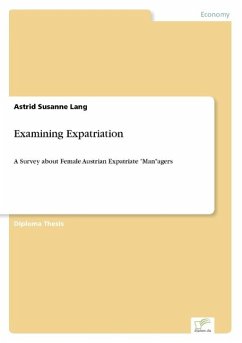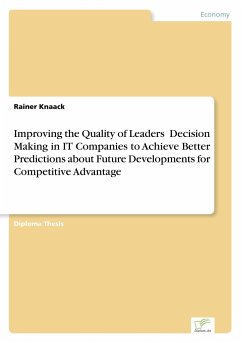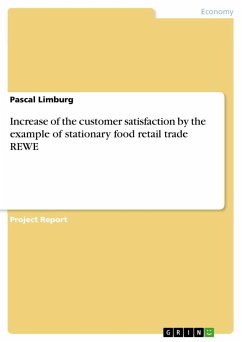Diploma Thesis from the year 2002 in the subject Business economics - Business Management, Corporate Governance, grade: 1,0, University of Applied Sciences Aalen (unbekannt), language: English, abstract: Inhaltsangabe:Abstract:
More and more companies apply electronic information systems in all their business areas. In the past, many of these systems pertained to one specific user group. However, due to high efforts and investments for maintaining these information flows, companies tend to increase the amount of attracted user groups. Thereby, the users must deal with more and more information every day. In addition, they must select the relevant information, which serves as a basis for their decisions, on their own. This procedure and the included irrelevant information generate high efforts due to re-work requirements. Therefore, users reject more and more information. All these conditions combined with a two-user group-oriented customer information system require output adjustments to the user-specific needs. Consequently, it is necessary to identify the users, their needs, and the potential effectiveness of specific information provided by a specific system.
This thesis refers to theoretical analysis models for generating an optimal concept. Thereby, it considers methods analyzing the original information system aim, user groups, their needs and the way the provided information flow can meet all these requests. These considerations represent actual conditions of Varta Gerätebatterie GmbH. Afterwards, this research compares the optimal with the actual situation in order to deduct appropriate improvement steps. Finally, this thesis suggests possible integrations and constitutes the related advantages and disadvantages based on cost accounting and information management theory.
The information flow analysis demonstrates the importance of finding appropriate methods and the key role of defining all users. Moreover, it emphasizes the significance of adjusting this flow to user needs in regular intervals due to the rapidly changing environment. The analysis of the information preparation and output indicates that communication plays a key role in exchanging information. The analysis of the optimal and the actual information system display several gaps, which VARTA should close. The actual situation analysis includes company conditions. Therefore, it is valid for practical implementation. These gaps pertain to the improvement procedure as well as to completely new integration issues.
Inhaltsverzeichnis:Table of Contents:
List of abbreviationsii
List of abbreviationsiii
Index of appendicesiv
List of definitionsvi
List of definitions (VARTA)vii
1.Introduction1
1.1Background to the research1
1.2Research problem, research issues and contributions2
1.3Justification for the research3
1.4Delimitations of scope and key assumptions3
2.Methodology4
2.1Research approach4
2.2Information model criteria4
2.3Procedure5
2.4Reliability and validity8
3.CIS-model8
3.1Determination of influence factors9
3.2Analysis of influence factors11
4.CIS status quo27
4.1Hierarchy27
4.2CIS information insert29
4.2.1Insert application software29
4.2.2Insert sources30
4.2.3Information preparation and output30
5.Gap-analysis35
5.1Customer status quo and estimated status quo35
5.1.1Improvements concerning insert and preparation36
5.1.2Improvements concerning layout output43
5.2Potential status quo43
5.3Gap concerning pricing, deviation and benchmarking44
6.Practical improvements45
6.1Pricing45
6.2Deviation analysis57
6.2.1ISC deviation methods58
6.2.2ISM deviation analysis output62
6.3Contribution benchmarking68
7.Conclusion72
Appendix 1 Tables75
Appendix 2 Figures89
Bibliog...
Hinweis: Dieser Artikel kann nur an eine deutsche Lieferadresse ausgeliefert werden.
More and more companies apply electronic information systems in all their business areas. In the past, many of these systems pertained to one specific user group. However, due to high efforts and investments for maintaining these information flows, companies tend to increase the amount of attracted user groups. Thereby, the users must deal with more and more information every day. In addition, they must select the relevant information, which serves as a basis for their decisions, on their own. This procedure and the included irrelevant information generate high efforts due to re-work requirements. Therefore, users reject more and more information. All these conditions combined with a two-user group-oriented customer information system require output adjustments to the user-specific needs. Consequently, it is necessary to identify the users, their needs, and the potential effectiveness of specific information provided by a specific system.
This thesis refers to theoretical analysis models for generating an optimal concept. Thereby, it considers methods analyzing the original information system aim, user groups, their needs and the way the provided information flow can meet all these requests. These considerations represent actual conditions of Varta Gerätebatterie GmbH. Afterwards, this research compares the optimal with the actual situation in order to deduct appropriate improvement steps. Finally, this thesis suggests possible integrations and constitutes the related advantages and disadvantages based on cost accounting and information management theory.
The information flow analysis demonstrates the importance of finding appropriate methods and the key role of defining all users. Moreover, it emphasizes the significance of adjusting this flow to user needs in regular intervals due to the rapidly changing environment. The analysis of the information preparation and output indicates that communication plays a key role in exchanging information. The analysis of the optimal and the actual information system display several gaps, which VARTA should close. The actual situation analysis includes company conditions. Therefore, it is valid for practical implementation. These gaps pertain to the improvement procedure as well as to completely new integration issues.
Inhaltsverzeichnis:Table of Contents:
List of abbreviationsii
List of abbreviationsiii
Index of appendicesiv
List of definitionsvi
List of definitions (VARTA)vii
1.Introduction1
1.1Background to the research1
1.2Research problem, research issues and contributions2
1.3Justification for the research3
1.4Delimitations of scope and key assumptions3
2.Methodology4
2.1Research approach4
2.2Information model criteria4
2.3Procedure5
2.4Reliability and validity8
3.CIS-model8
3.1Determination of influence factors9
3.2Analysis of influence factors11
4.CIS status quo27
4.1Hierarchy27
4.2CIS information insert29
4.2.1Insert application software29
4.2.2Insert sources30
4.2.3Information preparation and output30
5.Gap-analysis35
5.1Customer status quo and estimated status quo35
5.1.1Improvements concerning insert and preparation36
5.1.2Improvements concerning layout output43
5.2Potential status quo43
5.3Gap concerning pricing, deviation and benchmarking44
6.Practical improvements45
6.1Pricing45
6.2Deviation analysis57
6.2.1ISC deviation methods58
6.2.2ISM deviation analysis output62
6.3Contribution benchmarking68
7.Conclusion72
Appendix 1 Tables75
Appendix 2 Figures89
Bibliog...
Hinweis: Dieser Artikel kann nur an eine deutsche Lieferadresse ausgeliefert werden.








